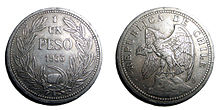peso
Peso (Spanish: "weight") denotes or denotes various currencies of several former Spanish colonies . The dollar sign $ originally stood for the Spanish-Mexican peso and was only used later for the US dollar . It is used today as the universal currency symbol for all currencies known as dollars or pesos. An exception is the Philippine peso , which has ₱ as a currency symbol.
Currencies
- Argentine Peso in Argentina
- Chilean Peso in Chile
- Colombian Peso in Colombia
- Cuban peso and convertible peso in Cuba
- Dominican Peso in the Dominican Republic
- Mexican peso in Mexico
- Philippine Peso in the Philippines
- Uruguayan Peso in Uruguay
In addition, the following supranational organizations use a peso as a unit of account :
- in the Sistema de Integración Centroamericana the Peso Centroamericano , whose exchange rate is 1: 1 to the US dollar ;
- in the Andean Community, the Andino peso .
Furthermore, the peso (divided into 100 centavos ) was the official currency:
- between 1963 and 1988 in Bolivia , replaced by the boliviano
- until 1925 in Guatemala , replaced by the Quetzal
- between 1975 and 1997 in Guinea-Bissau , replaced by the CFA franc when the country joined the UEMOA
- between 1862 and 1926 in Honduras , replaced by the Lempira
- until 1912 in Nicaragua , replaced by the Cordoba
- until 1919 in El Salvador , replaced by the Colón
Spain
The country of Spain itself had had the similar-sounding currency peseta since 1869 until the introduction of the euro as book money in 1999 and cash in 2002. Before that, there were in Spain: Obolo (13th century), Maravedí (from 15th century) and the parallel den Real (from 18th century), before the peseta (probably from "small piece") appeared in 1869.

